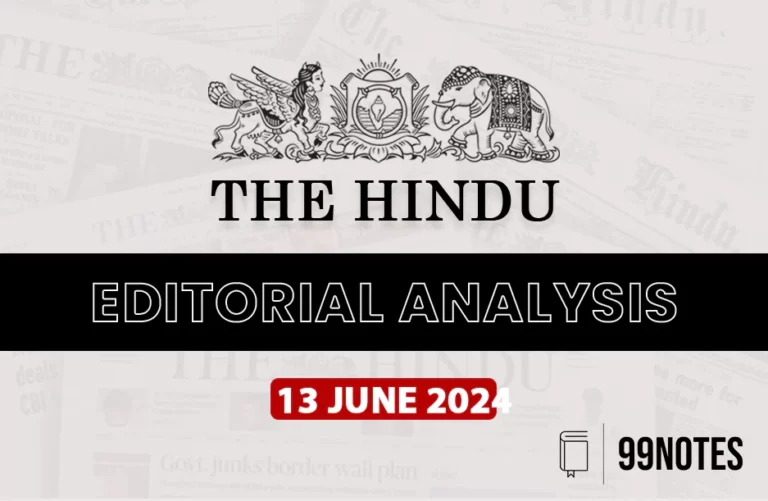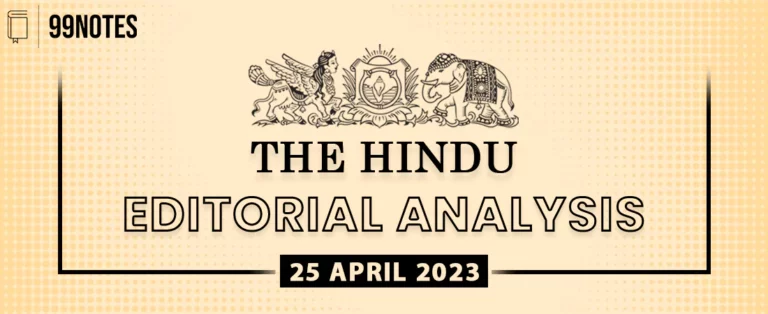5 April 2024 : The Hindu Editorial Notes PDF
The Hindu EDITORIAL
5-April-2024
1. Universities must budge on college autonomy nudge
|
Topic: GS2 – Social Justice – Education From a UPSC perspective, the article highlights the significance of autonomy in fostering innovation and excellence in higher education institutions. |
| Context |
| ● The article discusses the surge in applications for autonomous status among colleges following the UGC’s regulation, emphasizing the importance of autonomy in promoting innovation, academic excellence, and institutional accountability in higher education. |
Introduction:
- The National Education Policy 2020 emphasises the transformation of colleges into autonomous institutions to promote innovation and academic freedom.
- The University Grants Commission (UGC) introduced a regulation in April 2023 to facilitate the autonomy of colleges, resulting in a surge of applications.
Importance of Autonomous Colleges:
- Autonomous status fosters innovation, academic quality, and institutional excellence.
- Colleges can customize curriculum, experiment with teaching methods, and engage in research, enhancing educational outcomes.
Advantages of Autonomy:
- Autonomy cultivates accountability and responsibility among colleges, boosting institutional efficiency and motivation.
- It promotes pride and identity within colleges, motivating faculty and staff to strive for excellence.
Impact on NIRF Rankings:
- The NIRF Rankings of 2023 highlight the positive correlation between autonomy and academic excellence.
- Out of the top 100 colleges, 55 are autonomous, indicating the effectiveness of autonomy in enhancing institutional performance.
- Five out of the top 10 colleges in the NIRF Rankings are autonomous, showcasing their significant contribution to academic excellence.
Trend of Autonomous Colleges:
- The number of autonomous colleges is expected to reach 1,000 across various states and union territories.
- States like Andhra Pradesh, Karnataka, Maharashtra, Tamil Nadu, and Telangana lead in establishing autonomous colleges.
- Even states with fewer autonomous institutions recognize the transformative potential of autonomy in higher education.
Challenges Post-Autonomy:
- Some universities impose limitations on syllabus changes, hindering colleges’ autonomy in curriculum development.
- Delays in recognizing autonomy by universities disrupt college operations and undermine the autonomy spirit.
- Reluctance from universities to cede complete autonomy inhibits colleges’ ability to innovate and adapt.
- Arbitrary fees imposed by universities for affiliation raise concerns about transparency and fairness.
Addressing Post-Autonomy Challenges:
- State Councils for Higher Education must ensure effective implementation of UGC regulations on autonomy.
- Universities should streamline decision-making processes, fostering trust and collaboration with autonomous colleges.
- Collaboration between stakeholders is crucial for addressing challenges and creating a vibrant higher education ecosystem.
Conclusion:
- Successful autonomy implementation requires collaborative efforts from stakeholders to address challenges effectively and foster a dynamic higher education environment.
| Importance of college autonomy: |
|
● Enhanced Innovation: Autonomy allows colleges to design and modify their curriculum to meet evolving industry and societal needs, fostering innovative teaching and learning approaches. ● Academic Flexibility: Colleges can introduce new courses, revise syllabi, and experiment with teaching methodologies without bureaucratic constraints, promoting academic creativity and adaptability. ● Research Opportunities: Autonomous status empowers colleges to initiate and conduct research projects aligned with local, national, and global priorities, contributing to knowledge creation and dissemination. ●Quality Assurance: Colleges can establish stringent quality assurance mechanisms tailored to their unique academic goals and institutional culture, ensuring continuous improvement and academic excellence. ● Institutional Accountability: Autonomy encourages colleges to take ownership of their academic and administrative decisions, promoting transparency, efficiency, and accountability in institutional governance. ● Student-Centric Focus: Autonomous colleges can prioritise student needs and aspirations, offering customised academic programs, support services, and experiential learning opportunities to enhance student engagement and success. ● Faculty Empowerment: Autonomy provides faculty members with greater autonomy and professional autonomy to innovate in teaching, research, and institutional governance, fostering a culture of academic excellence and intellectual freedom. ●Global Competitiveness: Autonomous colleges can adapt quickly to changing educational trends and global standards, enhancing their competitiveness and reputation in the global higher education landscape. |
| PYQ: National Education Policy 2020 is in conformity with the Sustainable Development Goal-4 (2030). It intends to restructure and reorient education system in India. Critically examine the statement. (250 words/15m) (UPSC CSE (M) GS-2 2020) |
| Practice Question: How does autonomy contribute to enhancing innovation and academic excellence in higher education institutions, as per the discussed article? (150 Words /10 marks) |
2. Is the urban water system breaking?
|
Topic: GS1 – Indian Society – Urbanization, their problems and their remedies. Understanding urban water crises is crucial for addressing governance, sustainability, and environmental challenges in Indian cities, vital for UPSC. |
| Context |
| ● The article discusses Bengaluru’s water crisis, highlighting mismanagement, fragmented governance, and the need for integrated water management to address urban water challenges effectively. |
Introduction:
- Bengaluru, known for its pleasant climate and IT prowess, is grappling with a severe water crisis following the 2023 drought.
- The crisis underscores broader issues in urban water infrastructure across India.
Water Infrastructure Challenges:
- Bengaluru’s water crisis reflects mismanagement and urbanization challenges.
- The city has witnessed unplanned urbanization, leading to a loss of green cover and increased dependence on groundwater.
- Climate change exacerbates water scarcity, impacting surface water bodies like the Cauvery river.
Governance and Institutional Framework:
- Fragmented governance and lack of competent leadership hinder effective water management.
- Water supply, groundwater, surface water, and wastewater management operate in silos, contributing to mismanagement.
- Poor urban planning, including concretization and road construction, disrupts hydrological flows, exacerbating flooding.
Need for Integrated Water Management:
- Shift from supply-centric to ecologically sensitive water management is essential.
- Integrated institutions at the river basin level are necessary to address landscape issues like deforestation and pollution.
- Institutions must manage diverse water sources effectively, including rainwater, surface water, groundwater, and wastewater.
Impact of Urbanization:
- Urbanization, driven by economic opportunities, is irreversible.
- Infrastructure planning should anticipate and accommodate population growth, focusing on sustainability and livability.
Proposed Solutions:
- Promote cluster-based development to decongest cities and redistribute economic activities.
- Enhance ecosystem governance and protection, especially in river basins, to ensure sustainable water supply.
- Foster accountability and transparency in governance to address corruption and ensure effective planning and implementation.
Conclusion:
- Sustainable water management requires integrated institutions, long-term planning, and public accountability.
- Addressing water crises demands a shift towards holistic governance and ecosystem preservation to secure the future of cities like Bengaluru.
| Water scarcity in cities across India: |
|
Reasons for Water Scarcity in Indian Cities: ● Rapid Urbanization: Population growth and migration lead to increased demand for water, straining existing infrastructure. ●Inadequate Infrastructure: Insufficient water supply systems, leakages, and poor distribution networks contribute to scarcity. ● Depletion of Water Sources: Overexploitation of groundwater, depletion of aquifers, and pollution of surface water sources exacerbate scarcity. ●Climate Change: Erratic rainfall patterns, droughts, and heatwaves worsen water availability in cities. ●Poor Water Management: Inefficient water governance, lack of proper planning, and ineffective water resource management practices contribute to scarcity. ● Pollution: Contamination of water bodies due to industrial discharge, untreated sewage, and solid waste disposal impacts water quality and availability. ●Unequal Access: Socioeconomic disparities result in unequal access to water, with marginalized communities facing greater challenges. Way Forward to Address Water Scarcity: ● Sustainable Water Management: Implementing efficient water management practices, including rainwater harvesting, wastewater recycling, and conservation measures. ● Infrastructure Development: Investing in robust water supply systems, infrastructure upgrades, and piped water connections to ensure equitable access. ●Conservation Awareness: Promoting water conservation awareness campaigns and incentivizing water-saving practices among citizens. ● Pollution Control: Enforcing stringent regulations to control industrial pollution, sewage treatment, and waste management to protect water bodies. ●Climate Resilience: Building climate-resilient infrastructure, implementing drought management strategies, and promoting water-saving technologies. ● Community Participation: Involving local communities in water management initiatives, empowering them to participate in decision-making processes. ● Policy Reforms: Formulating integrated water policies, strengthening water governance mechanisms, and enhancing coordination among stakeholders. Addressing water scarcity requires a multi-faceted approach encompassing sustainable management practices, infrastructure development, community engagement, and policy reforms to ensure water security and resilience in Indian cities. |
| PYQ: Why is the world today confronted with a crisis of availability of and access to freshwater resources?(150 words/10m) (UPSC CSE (M) GS-1 2023) |
| Practice Question: How does fragmented governance contribute to urban water crises, as observed in Bengaluru, and what are the implications? (250 Words /15 marks) |
For Enquiry

5 April 2024 : The Hindu Editorial Notes PDF

5 April 2024 : Indian Express Editorial Analysis

4 April 2024 : Daily Answer Writing

4 April 2024 : Daily Current Affairs Quiz

4 April 2024 : Daily Current Affairs

4 April 2024 : PIB Summary for UPSC

4 April 2024 : The Hindu Editorial Notes PDF

4 April 2024 : Indian Express Editorial Analysis

3 April 2024 : Daily Current Affairs Quiz

3 April 2024 : Daily Answer Writing
April 2024 The Hindu Editorial 5 April 2024 : The Hindu Editorial Notes PDF The Hindu EDITORIAL
5-April-2024
1. Universities must budge on college autonomy nudge
Topic: GS2…
April 2024 Indian Express 5 April 2024 : Indian Express Editorial Analysis Indian Express Editorial Analysis
5-April-2024
1. The healthcare promise
Topic: GS2 – Governance…
mains answer writing 4 April 2024 : Daily Answer Writing Mains Answer Writing
4-April-2024
Q1) Historical and cultural affinities between India and Nepal create…
Daily Quiz 4 April 2024 : Daily Current Affairs Quiz 4 April 2024 : Daily Quiz…
April 2024 Daily Current Affairs 4 April 2024 : Daily Current Affairs Daily Current Affairs
4-April -2024- Top News of the Day
1. Taiwan Rattled: Deadly Earthquake Strikes…
April 2024 PIB 4 April 2024 : PIB Summary for UPSC PIB Summary for UPSC
4-April-2024
1. Union Health Ministry launches myCGHS iOS app
Topic: GS2 –…
April 2024 The Hindu Editorial 4 April 2024 : The Hindu Editorial Notes PDF The Hindu EDITORIAL
4-April-2024
1. Turning the spotlight on the urban poor.
Topic: GS2 – Social…
April 2024 Indian Express 4 April 2024 : Indian Express Editorial Analysis Indian Express Editorial Analysis
4-April-2024
1. The demographic window
Topic: GS1 – Society –…
Daily Quiz 3 April 2024 : Daily Current Affairs Quiz 3 April 2024 : Daily Quiz…
mains answer writing 3 April 2024 : Daily Answer Writing Mains Answer Writing
3-April-2024
Q1) Rapidly evolving balance of power has the potential to realign…


